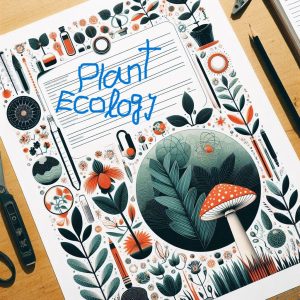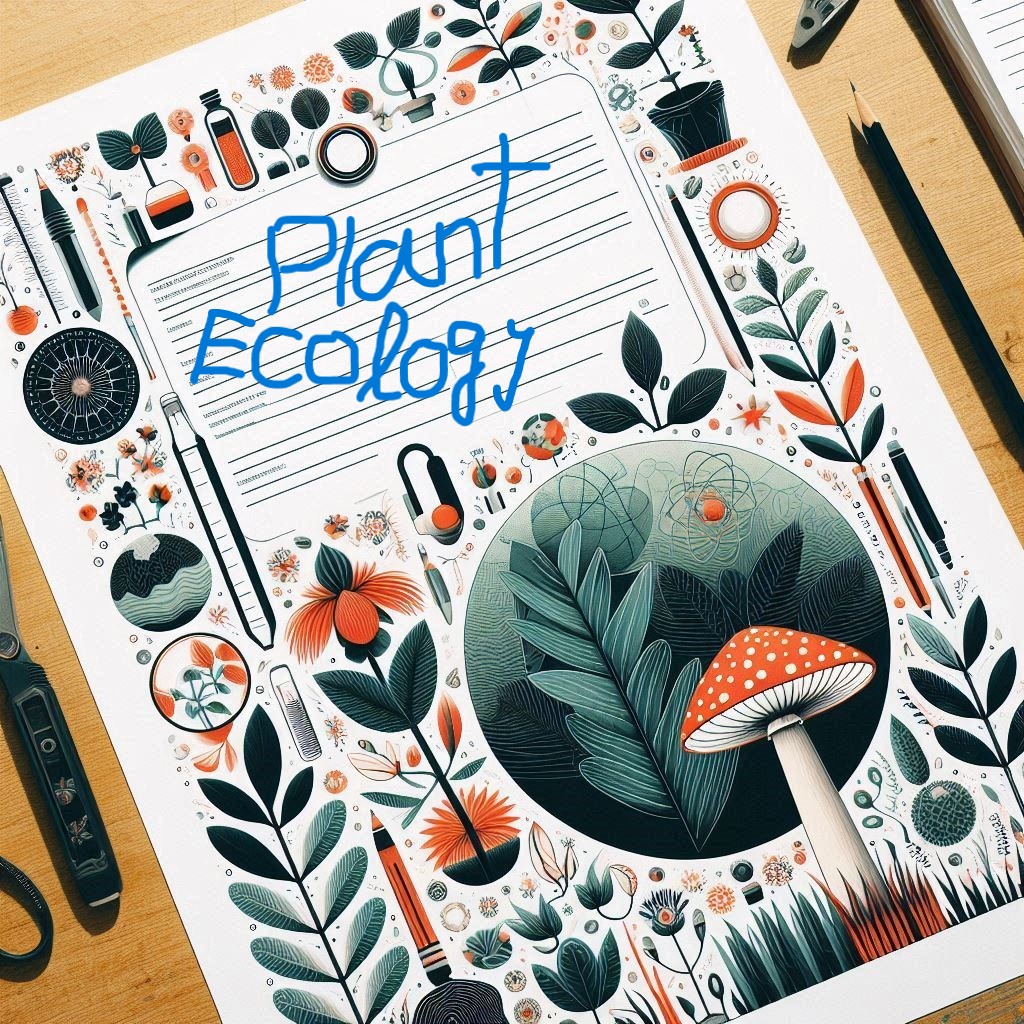1. Core Concepts in Plant Ecology
Plant ecology encompasses several fundamental concepts, including:
- Ecological Niche: The role a plant species plays within its environment, including its interactions with other species and its habitat requirements.
- Plant Communities: Groups of plant species that live together in a specific area, influenced by environmental factors and interspecies relationships.
- Ecosystem Services: Benefits that plants provide to ecosystems, such as air and water purification, soil stabilization, and habitat provision.
Plant Ecology
1. Ecological Niche
The ecological niche of a plant species describes its role within an ecosystem, including its habitat, its interactions with other species, and its ecological requirements. The niche encompasses both the fundamental niche (the full range of conditions under which a plant can survive) and the realized niche (the conditions under which it actually lives due to competition and other factors). Understanding the ecological niche is crucial for predicting how changes in the environment may affect plant distribution and interactions.
For more information on ecological niches, visit Britannica’s article on ecological niche.
2. Plant Communities
Plant communities are groups of plant species that coexist in a particular area and interact with each other and their environment. These communities can vary greatly in terms of species composition and structure, influenced by factors such as soil type, climate, and disturbance. Plant communities can be classified into different types, such as forests, grasslands, and wetlands, each with its own characteristic plant assemblages.
Learn more about plant communities at ScienceDirect’s overview of plant communities.
3. Ecosystem Services
Ecosystem services are the benefits that plants provide to ecosystems and humans. These services include:
- Air and Water Purification: Plants help filter pollutants from air and water, improving overall environmental quality.
- Soil Stabilization: Plant roots stabilize soil and prevent erosion, reducing the risk of landslides and maintaining soil health.
- Habitat Provision: Plants provide habitats for a wide range of animal species, contributing to biodiversity.
Explore the concept of ecosystem services further at Nature’s article on ecosystem services.
4. Plant Adaptations
Plants have developed various adaptations to survive in different environments. These adaptations can be structural, physiological, or behavioral:
- Structural Adaptations: Physical changes such as leaf shape, root depth, and stem thickness that help plants cope with environmental conditions.
- Physiological Adaptations: Internal processes such as water conservation, nutrient uptake, and metabolic adjustments to environmental stress.
- Behavioral Adaptations: Growth patterns and reproductive strategies that enhance survival and reproductive success.
For a deeper dive into plant adaptations, check out Springer’s publication on plant adaptations.
5. Plant Competition and Succession
Competition among plant species for resources such as light, water, and nutrients can shape plant communities. Plant succession is the process by which the species composition of a community changes over time, often following disturbances. Understanding these processes is essential for managing ecosystems and restoring degraded areas.
Learn more about plant competition and succession at Annual Review’s article on plant succession.
2. Plant Adaptations
Plants have evolved various adaptations to survive and thrive in different environments. These adaptations include:
- Structural Adaptations: Physical changes such as leaf shape, root systems, and stem structures that help plants cope with environmental conditions.
- Physiological Adaptations: Internal processes such as water conservation, nutrient uptake, and photosynthesis adjustments.
- Behavioral Adaptations: Changes in growth patterns and reproductive strategies to maximize survival and reproduction.
Structural Adaptations
Structural adaptations involve physical changes in the plant’s body that improve its ability to handle environmental stressors. Examples include:
- Leaf Modifications: Plants in arid environments often have small, waxy leaves or needle-like structures to minimize water loss. For instance, cacti have evolved thick, fleshy leaves that store water.
- Root Systems: In nutrient-poor soils, plants develop extensive root networks or specialized roots such as mycorrhizal roots that enhance nutrient uptake.
- Thorns and Spines: Many plants, such as roses and acacias, develop thorns and spines to deter herbivores and reduce grazing pressure.
Explore more about structural adaptations in plants at Springer’s publication on plant adaptations.
Physiological Adaptations
Physiological adaptations are internal changes in metabolic processes that help plants cope with environmental stress. Key examples include:
- Water Conservation: Many desert plants employ mechanisms like CAM (Crassulacean Acid Metabolism) to open their stomata at night, reducing water loss while still allowing for CO2 uptake.
- Osmoregulation: Plants maintain cellular water balance by adjusting solute concentrations within their cells. This process is crucial for surviving in saline or arid environments.
- Nutrient Acquisition: Some plants form symbiotic relationships with soil microbes to enhance nutrient uptake, particularly in nutrient-deficient soils.
For detailed insights into physiological adaptations, check out Springer’s book on plant physiology.
Behavioral Adaptations
Behavioral adaptations are changes in growth patterns or reproductive strategies that help plants survive and reproduce. Examples include:
- Phototropism: Plants such as sunflowers exhibit phototropism, where they grow toward light sources to maximize photosynthesis.
- Reproductive Strategies: Plants like orchids employ specialized pollination strategies to attract specific pollinators.
- Tropisms: Plants exhibit various tropisms (e.g., gravitropism, hydrotropism) to orient their growth in response to environmental stimuli.
Discover more about behavioral adaptations at Springer’s book on plant behavior.
3. Plant Interactions
Plants interact with other organisms and their environment in complex ways. Key interactions include:
- Symbiosis: Mutualistic relationships between plants and other organisms, such as mycorrhizal fungi and nitrogen-fixing bacteria.
- Herbivory: Interactions between plants and herbivores, including plant defenses and herbivore adaptations.
- Competition: Competition for resources like light, water, and nutrients among different plant species.
Types of Plant Interactions
Plant interactions can be classified into several key types, each with distinct characteristics and ecological implications:
1. Competition
Competition occurs when plants vie for the same resources, such as light, water, and nutrients. This interaction can be intraspecific (between individuals of the same species) or interspecific (between individuals of different species). For instance, tall trees in a forest compete for sunlight, while herbaceous plants might compete for soil nutrients.
Explore more on plant competition at Springer’s book on plant competition.
2. Mutualism
Mutualistic interactions benefit both participating plants. Examples include:
- Mycorrhizal Symbiosis: Fungi form symbiotic relationships with plant roots, aiding in nutrient uptake, particularly phosphorus, in exchange for carbohydrates.
- Pollination: Plants like orchids and bees engage in mutualistic interactions where bees gain nectar and plants receive pollination services.
Read more about mutualistic plant interactions at Springer’s book on plant mutualism.
3. Allelopathy
Allelopathy is a type of interaction where plants release chemicals into the environment that can inhibit the growth of neighboring plants. This phenomenon can be competitive or inhibitory. For example, black walnut trees release juglone, a chemical that suppresses the growth of many plants.
For a comprehensive look at allelopathy, visit ScienceDirect’s overview.
Plant Interactions and Ecosystem Dynamics
The interactions between plants not only affect individual species but also have significant impacts on ecosystem dynamics:
- Biodiversity: Plant interactions can influence species diversity within an ecosystem. For example, mutualistic relationships can enhance the survival of multiple species, leading to greater biodiversity.
- Succession: As plant communities evolve over time, interactions between species play a crucial role in ecological succession, shaping the structure and composition of plant communities.
Learn more about ecosystem dynamics and plant interactions at Springer’s book on ecosystem dynamics.
4. Applications of Plant Ecology
Plant ecology has practical applications in various fields, including:
- Agriculture: Improving crop management practices and sustainable agriculture through understanding plant-environment interactions.
- Conservation: Developing strategies for preserving plant biodiversity and managing protected areas.
- Restoration Ecology: Restoring degraded ecosystems by reintroducing native plant species and improving soil health.
1. Conservation and Biodiversity
One of the key applications of plant ecology is in conservation and biodiversity management. Understanding plant species’ roles and interactions helps in developing strategies for protecting endangered species and preserving natural habitats. For example, conservationists use ecological data to identify critical habitats and implement restoration projects.
Explore more on plant conservation at IUCN’s conservation resources.
2. Sustainable Agriculture
Plant ecology contributes significantly to sustainable agriculture. Understanding plant interactions and soil ecology can improve crop management and increase agricultural productivity while minimizing environmental impact. Techniques such as crop rotation and cover cropping are informed by ecological principles to enhance soil health and reduce pest populations.
Read more about sustainable agriculture practices at UN Sustainable Development Goals.
3. Urban Planning and Green Spaces
Plant ecology plays a vital role in urban planning and the design of green spaces. Integrating ecological principles into city planning helps create healthier urban environments, manage urban heat islands, and enhance the aesthetic and recreational value of green spaces. For example, urban planners use ecological data to design green roofs and community gardens that support biodiversity and provide ecosystem services.
Learn more about urban green spaces at National Geographic’s article on urban green spaces.
4. Climate Change Mitigation
Plant ecology is crucial in climate change mitigation. Plants play a significant role in carbon sequestration, which helps reduce greenhouse gases in the atmosphere. Understanding plant species’ responses to climate change, such as shifts in phenology and distribution, enables better predictions and management strategies. For instance, IPCC reports use ecological models to assess how different plant species contribute to carbon storage and adaptation strategies.
Read more about the role of plants in climate change at WMO’s climate change resources.
5. Ecological Restoration
Plant ecology is fundamental to ecological restoration, which aims to rehabilitate degraded ecosystems. Restoration projects often involve replanting native species, controlling invasive species, and restoring natural processes. Understanding plant community dynamics and soil interactions is crucial for successful restoration efforts. For instance, restoration projects use ecological principles to guide the recovery of ecosystems impacted by human activities.
Explore more about ecological restoration at Conservation International’s restoration efforts.

5. Future Directions in Plant Ecology
Future research in plant ecology is likely to focus on:
- Climate Change: Understanding how changing climates impact plant distribution and ecosystem services.
- Urban Ecology: Studying plant interactions in urban environments to improve green spaces and resilience.
- Genomic Approaches: Utilizing plant genomics to unravel complex ecological interactions and adaptation mechanisms.
1. Integration of Advanced Technologies
Future plant ecology research will increasingly incorporate advanced technologies to enhance data collection, analysis, and modeling. Techniques such as remote sensing, drones, and genomic tools will provide unprecedented insights into plant health, distribution, and interactions. These technologies will improve our understanding of plant ecosystems and enable more precise monitoring and management.
Explore more about technological advancements in ecology at Ecology and Society.
2. Climate Change Adaptation
As climate change continues to impact ecosystems, plant ecologists are focusing on adaptation strategies for plant species and ecosystems. Research will explore how plants can adapt to changing temperatures, precipitation patterns, and increased CO2 levels. Strategies may include genetic adaptation and assisted migration. Understanding these processes will help in developing effective conservation and management strategies.
Learn more about climate change adaptation at IPCC’s climate change reports.
3. Enhancing Biodiversity Conservation
Future directions in plant ecology will emphasize biodiversity conservation to protect and restore plant species and habitats. Research will focus on identifying and preserving biodiversity hotspots, managing invasive species, and restoring degraded ecosystems. Advanced tools and methodologies will aid in monitoring species populations and assessing conservation efforts.
Explore current biodiversity conservation strategies at Conservation International.
4. Interdisciplinary Research and Collaboration
The future of plant ecology will involve greater interdisciplinary collaboration with fields such as remote sensing, climate science, and sociology. Collaborative research will address complex ecological issues and integrate diverse perspectives to develop holistic solutions. This approach will enhance our ability to tackle global challenges and promote sustainable practices.
Read more about interdisciplinary research at Nature Reviews Interdisciplinary Research.
5. Application of Ecological Modeling
Ecological modeling will play a crucial role in predicting future scenarios and informing decision-making. Ecological models will be used to simulate plant responses to environmental changes, assess ecosystem services, and guide conservation and management strategies. Advances in computational power and modeling techniques will enhance the accuracy and applicability of these models.
Learn more about ecological modeling at Ecology and Society’s articles on modeling.
Related Links
1. What is Plant Ecology?

Plant ecology is the study of the relationships between plants and their environment. It involves understanding plant distribution, abundance, interactions with other organisms, and how they respond to environmental changes. The field helps in managing ecosystems and addressing environmental challenges.
2. Why is Plant Ecology Important?
Plant ecology is crucial for understanding ecosystem dynamics, conserving biodiversity, and managing natural resources. It provides insights into how plants interact with their environment and other species, which is essential for sustainable agriculture, conservation efforts, and climate change adaptation.
3. What Are the Core Concepts of Plant Ecology?
Core concepts in plant ecology include plant adaptations, plant interactions, plant communities, and the role of plants in ecosystem processes. Understanding these concepts helps in studying plant behavior, ecosystem health, and the impact of environmental changes on plant life.
4. How Does Plant Ecology Apply to Environmental Management?
Plant ecology informs environmental management by providing knowledge about plant species’ roles in ecosystems, how they respond to disturbances, and strategies for conservation. This information is used to design effective management plans, restore degraded habitats, and mitigate the effects of climate change.
5. What Are Some Future Directions in Plant Ecology?
Future directions in plant ecology include integrating advanced technologies, studying climate change impacts, enhancing biodiversity conservation, and applying ecological modeling. These areas of focus will help address pressing environmental issues and improve our understanding of plant-environment interactions.
Disclaimers
The information provided in this article is for educational purposes only and should not be considered as professional advice. While every effort has been made to ensure the accuracy of the content, the field of plant ecology is continually evolving, and new research may provide updated insights. Always consult with a qualified ecologist or environmental scientist for specific advice and guidance. I mentioned again that The information provided in this article is for educational purposes only and is not intended as a substitute for professional advice or scientific research.
Cautions
1. Fieldwork Risks: When engaging in fieldwork for plant ecology, be aware of potential risks such as exposure to hazardous plants, insects, or environmental conditions. Ensure proper safety measures and precautions are in place.
2. Ethical Considerations: Conduct plant ecology research and management activities ethically, respecting local regulations and the conservation status of plant species. Avoid causing harm to ecosystems or disrupting natural habitats.
3. Data Interpretation: Interpret ecological data with caution, as plant-environment interactions can be complex and influenced by multiple factors. Consider seeking peer review or consulting with experts to validate findings and conclusions.
I mentioned again that, The information provided in this article is for educational purposes only and is not intended as a substitute for professional advice or scientific research.



